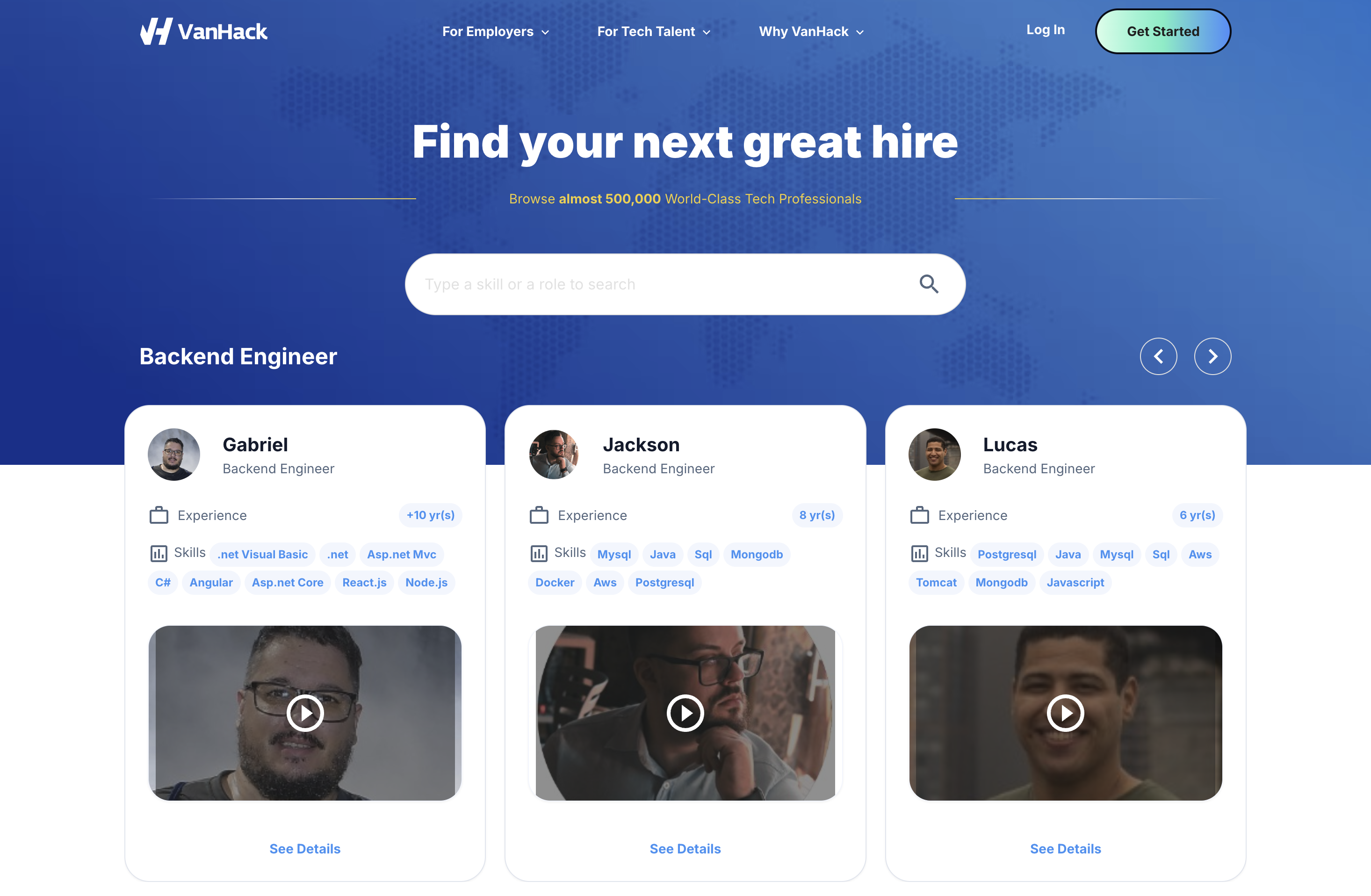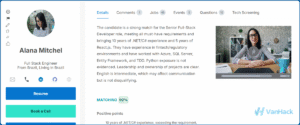Finding skilled .NET developers in the US often means high costs and long wait times. Hiring remotely from Latin America offers a practical solution, giving access to talented professionals at lower costs while ensuring smooth team collaboration. This guide helps US companies navigate the process of building effective distributed .NET teams with Latin American talent. Start hiring with VanHack to connect with pre-vetted .NET developers from LATAM today.
Why Global Talent Should Be Your Focus Now
The demand for engineering talent has turned hiring into a key factor for business growth. In the US, filling senior .NET roles can take over 90 days, delaying projects and impacting market position. Companies need to prioritize strategic hiring to stay competitive.
Talent acquisition goes beyond just filling jobs. It involves planning for future needs, strengthening your employer brand, and maintaining a pipeline of qualified candidates. For senior roles, you need developers with 5-8 years of experience for specific technical skills, staff engineers with 8-12 years for system design, and principal engineers with over 12 years for strategic impact.
When deciding on hiring strategies, weigh the costs of building an in-house team against partnering with global platforms. Internal teams can cost $80,000 to $120,000 per recruiter annually, plus tools and delayed project costs. A specialized platform can save time and resources while delivering results.
Effective hiring ties directly to business success. Having the right .NET skills at the right time ensures product development stays on track. Investors often look at team-building speed as a sign of capability, and faster feature delivery can strengthen your market standing.
Benefits of Hiring .NET Developers from Latin America
Lower Costs with High-Quality Results
Hiring .NET developers from LATAM can reduce costs by 45-60% compared to US salaries, without compromising on quality. Mid-level developers in the region earn between $35,000 and $45,000 yearly, while senior roles range from $40,000 to $60,000, with some reaching $70,000 in high-demand areas. In contrast, similar US roles cost $120,000 to $180,000.
Paying in USD offers a competitive edge for LATAM developers due to exchange rates, helping attract skilled professionals at reasonable rates. This also means savings on benefits and overhead, allowing for sustainable team growth.
Strong Technical Skills for Modern Projects
LATAM .NET developers bring expertise in areas like ASP.NET Core, Entity Framework, Azure, and microservices. Their skills match the needs of today’s enterprise projects, enabling quick contributions with minimal training.
Many have experience with US-based teams, giving them insight into American business practices and agile workflows. This familiarity helps ease integration into existing setups.
Their strengths cover full-stack .NET development, from frontend interfaces to backend architecture, with a focus on cloud solutions like Azure. This versatility ensures they can handle diverse project demands efficiently.
Easy Collaboration with Time Zone and Cultural Alignment
LATAM’s time zones are close to US hours, often differing by just 1-4 hours. This overlap supports real-time teamwork for daily meetings, sprint planning, and quick problem-solving, avoiding delays common with farther regions.
Cultural similarities between LATAM and US teams often simplify remote work dynamics. Shared work values can reduce misunderstandings and help build stronger team connections over time.
English proficiency among LATAM developers is also rising, with many able to handle technical conversations, code reviews, and stakeholder communication effectively, creating a solid foundation for distributed teams.
Salary Ranges Across LATAM Markets
Pay varies by country in Latin America, impacting hiring budgets. In Argentina, remote developers can earn closer to $58,000 annually when working for international firms, though local averages are around $21,300. Other averages include Mexico at $28,420 and Colombia at $25,150 for local roles.
Remote positions paid in USD often exceed local rates, with most software engineers earning between $25,000 and $45,000 yearly. These figures help US companies set realistic salary expectations for planning purposes.
How to Hire Remote LATAM .NET Talent Successfully
Plan Your Needs and Assess Readiness
Start by aligning hiring with business goals. Focus on .NET roles that deliver the most value, like senior developers who can design solutions and guide newer team members. This ensures immediate impact on critical projects.
Evaluate your company’s readiness for remote hires. Check your current tools, communication setups, and management practices for supporting international staff. Identifying gaps early helps smooth out the integration process.
Prioritize hires based on project timelines. Backend .NET developers often come first to build core systems, followed by frontend or full-stack roles. This order ensures technical leadership is in place to support the team.
Source and Vet Candidates Effectively
Standard job boards like LinkedIn often yield too many unqualified applicants, wasting time on screening. Generic recruiting lacks the depth to properly evaluate .NET skills, leading to poor matches and delays.
Specialized platforms solve this by offering curated candidates vetted for technical ability, language skills, and cultural fit. Connect with top LATAM talent through VanHack to cut down hiring time and improve match quality.
VanHack’s Detailed Vetting for .NET Developers
VanHack uses a thorough process to assess candidates, blending human review with technology for reliable results. This approach provides deeper insights than traditional methods, helping you hire with confidence.
Here’s how VanHack evaluates talent:
- Video introductions, lasting 1-2 minutes, show communication skills and English level, letting managers gauge fit without initial interviews.
- AI-driven technical interviews, about 30 minutes long, capture problem-solving and reasoning through recorded sessions, complete with transcripts and scores.
- Objective coding tests measure real development skills against industry standards, removing bias and confirming ability with clear data.

Streamline Interviews and Onboarding
With technical skills already verified by VanHack, interviews can focus on cultural fit and team alignment. This saves time and lets you assess communication style and values directly.
Use structured interviews for consistency. Include behavioral questions on remote work, technical talks on system design, and scenarios to test problem-solving. This ensures a full picture of each candidate quickly.
Plan integration before hiring. Set up clear communication rules, define roles, and prepare mentors. Have technical setups, access, and documentation ready so new hires can start working right away.
Build a Strong Remote Team Culture
Help LATAM .NET developers feel like core team members by including them in team activities, offering growth paths, and involving them in key discussions. Recognize their work to boost loyalty and retention.
For communication, rely on async tools, detailed documentation, and regular meetings like daily standups or weekly reviews. Set clear expectations for response times to keep everyone aligned across time zones.
Measure performance by outcomes, not hours. Focus on code quality, delivery speed, and project impact. Provide regular feedback and growth opportunities to show commitment to their success.
Choosing the Right Hiring Approach for .NET Developers
In-House Teams vs. External Partners
Deciding between building an internal hiring team or using external services depends on your company’s size and needs. In-house teams offer control but come with high costs, including recruiter salaries of $80,000 to $120,000 yearly, plus tools and management expenses.
External partners provide access to expertise and candidate networks without ongoing costs. They adapt to changing hiring demands and deliver faster results. Consider both cost and speed when choosing your path.
Factor in hidden costs like training, tools, and delays in hiring that slow down projects. These can affect customer commitments and market position, impacting overall expenses beyond just salaries.
Comparing Hiring Solutions for .NET Talent
|
Feature / Service |
Traditional Agency |
In-House Team |
VanHack |
|
Cost Model |
Per-hire fee (20-30% of salary) |
FTE Cost + Tools ($100K+) |
Flat Monthly Fee ($3K unlimited hires) |
|
Candidate Vetting |
Basic resume screening |
Resource-intensive custom process |
Multi-dimensional AI + Video + Coding |
|
Time-to-Hire |
60-90 days average |
45-60 days (with ramp-up) |
14-21 days (pre-vetted shortlist) |
|
Global Mobility Support |
None provided |
Company’s full responsibility |
Full-Service Immigration & Relocation |
This table shows the distinct benefits of platforms focused on LATAM hiring. Traditional agencies offer little for international roles, and in-house efforts require heavy investment. Hire faster with VanHack to access proven processes that shorten timelines while ensuring quality.
Common Mistakes to Avoid When Hiring LATAM .NET Talent
Using general hiring methods for remote roles often fails. International hires need focused vetting for communication, cultural fit, and technical skills. Standard approaches can lead to higher turnover and slower onboarding.
Ignoring cultural integration and communication practices creates tension in distributed teams. Invest in relationship-building, clear guidelines, and training for existing staff to support long-term collaboration.
Focusing only on cost savings misses the bigger picture. While LATAM hires are more affordable, their real value lies in driving project speed and quality. Look at overall impact, not just salary differences.
Applying basic interviews for senior .NET roles overlooks key skills like system design and leadership. Tailored assessments are necessary to ensure hires match the demands of complex positions.
Key Facts About Hiring LATAM .NET Developers
Skill Levels Compared to US Developers
LATAM .NET developers often match or surpass US talent in technical ability. Many have worked with American teams, gaining exposure to US standards and practices. Their expertise covers ASP.NET Core, Entity Framework, Azure, and microservices, bringing both depth and fresh ideas to projects.
Cost Savings for US Companies
By hiring from LATAM, US companies can save 45-60% on salaries. Mid-level developers earn $35,000 to $45,000 annually, and senior roles range from $40,000 to $60,000, compared to $120,000 to $180,000 in the US. These savings also reduce benefits and recruiting costs, freeing up funds for other priorities.
Time Zone Benefits for Collaboration
LATAM time zones align well with US hours, differing by just 1-4 hours. This allows for overlapping schedules, supporting live meetings, code reviews, and quick issue resolution, which boosts team productivity and project speed.
Core Technical Skills of LATAM Developers
These developers excel in the Microsoft tech stack, including ASP.NET Core, SQL Server, Entity Framework, and Azure services. They’re skilled in microservices, API design, and integrating modern frontend tools with .NET systems, ready to tackle complex projects from day one.
How VanHack Supports Hiring Needs
VanHack connects US companies with pre-vetted LATAM .NET talent for remote roles. It provides 3-5 matched candidates per position using AI tools, video assessments, technical interviews, and coding tests. The ‘Vanna’ subscription offers unlimited hires for $3,000 monthly, and relocation services are available for companies needing in-person staff.
Build Your Team with LATAM .NET Talent Through VanHack
Hiring .NET developers from Latin America gives US companies a competitive edge by combining skilled professionals, cost savings, and effective collaboration. These developers offer expertise in current .NET tools and enterprise practices for quick project impact.
Success hinges on thorough vetting for skills, communication, and team fit. Standard recruiting falls short for international hires, making specialized platforms essential for navigating technical and cultural needs.
VanHack addresses these challenges with AI matching, detailed candidate reviews, and a flat-rate pricing model. It focuses on senior engineers with 5-10 years of experience, cutting hiring time while ensuring quality.
Companies adopting this approach gain access to wider talent pools and faster development cycles. Time zone and cultural alignment further support lasting team success.
Looking to build a strong tech team efficiently? Connect with skilled LATAM developers ready for your projects. Find the best talent now with VanHack and elevate your hiring strategy.



